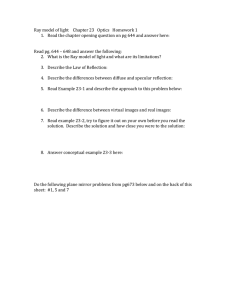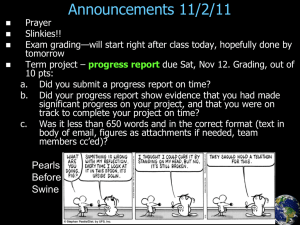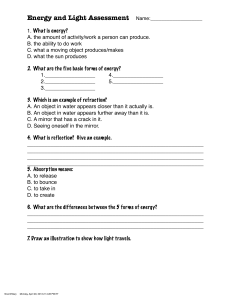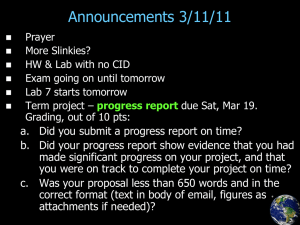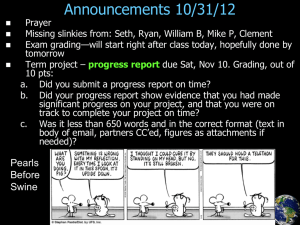Announcements 11/3/10
advertisement
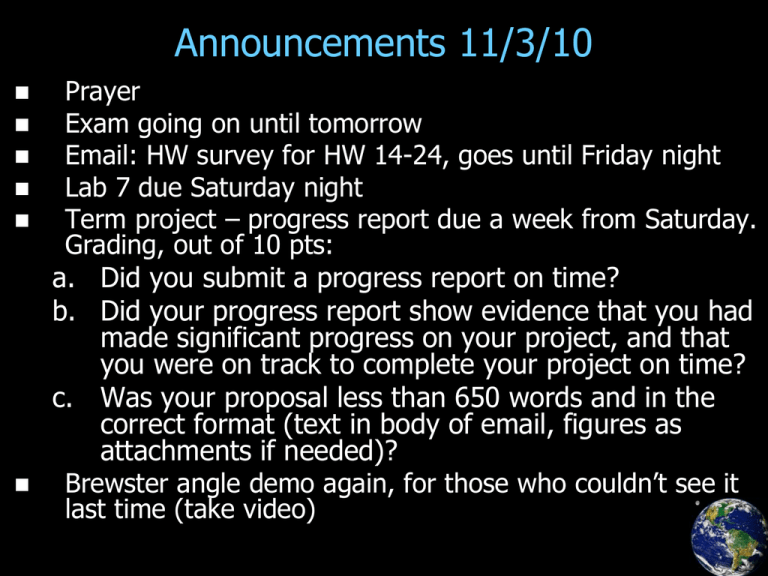
Announcements 11/3/10 Prayer Exam going on until tomorrow Email: HW survey for HW 14-24, goes until Friday night Lab 7 due Saturday night Term project – progress report due a week from Saturday. Grading, out of 10 pts: a. Did you submit a progress report on time? b. Did your progress report show evidence that you had made significant progress on your project, and that you were on track to complete your project on time? c. Was your proposal less than 650 words and in the correct format (text in body of email, figures as attachments if needed)? Brewster angle demo again, for those who couldn’t see it last time (take video) What’s an image? When you look at it, it looks like there’s an object present (but there isn’t, really) Real a. The light rays you see are all coming from the location of the image Virtual a. The light rays you see all just seem to be coming from the location of the image Reading quiz Is the image you see behind a mirror real or virtual? a. Real b. Virtual How can you ever get a real image to form with a mirror? A Real Image Use a curved mirror On the advantages of arrows… Reading Quiz What is the focal length of a concave mirror with a radius R? a. R b. -R c. R/2 d. -R/2 e. R2 Proved in a HW problem Demos Saucer real image or not. Class poll: What kind of image is this? a. Real b. Virtual Spherical mirror with hanging ball pendulum Curved mirrors Not just any curve will work Fig 36.8 Fig 36.10 Focus: a. every ray coming in parallel will pass through focus b. Every ray passing through focus will exit parallel I will always use f, not R (f=R/2) “paraxial rays” Where will it “focus”? focus useful “third ray”: center of mirror is flat The equation p ho hi focus f q Similar triangles: hi q ho p Similar triangles: hi f hi ho p The equation: 1 1 1 p q f Magnification p ho hi focus f Similar triangles hi q ho p hi Define M: M ho q Useful way q to calculate: M Force M to be negative if image is inverted. p Demo Inverted image in light bulb “Convex mirror”: curved the other way The equation: 1 1 1 p q f virtual image! but f is negative Numbers: f = -5.5 cm, p = 16.5 cm, q = ? -4.1 cm Negative q: means image is in back of mirror Thought question Does a concave (converging) mirror always form a real image? a. Yes b. No Thought question I look at my image in a round Christmas ornament. Which of the following will be true? a. The image will be upright (not inverted) and real. b. The image will be upright and virtual. c. The image will be inverted and real. d. The image will be inverted and virtual. e. Can’t say… it will depend on where you (the object) are relative to the focus. Rest of time: class-designed problems p = _____ f = _____ Including some with: 1) concave “converging” mirrors (f = +17 cm, +27 cm), and 2) convex “diverging” mirrors (f = -22 cm), which we can test out! ray diagram = ? q=?
